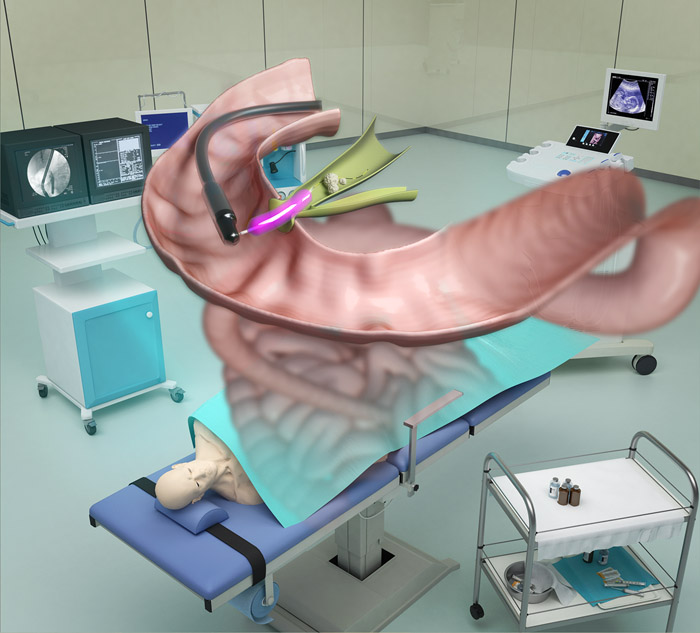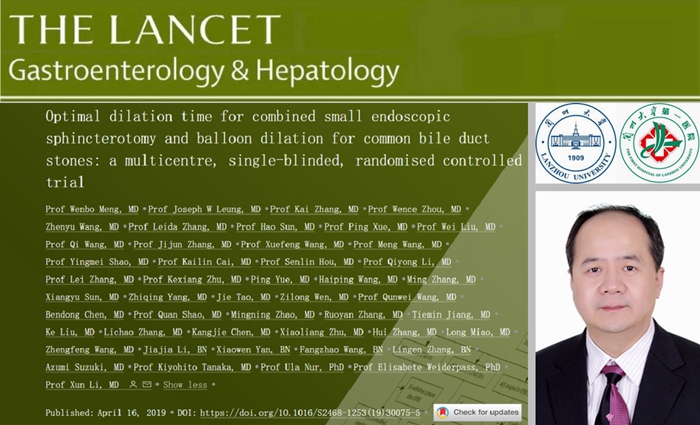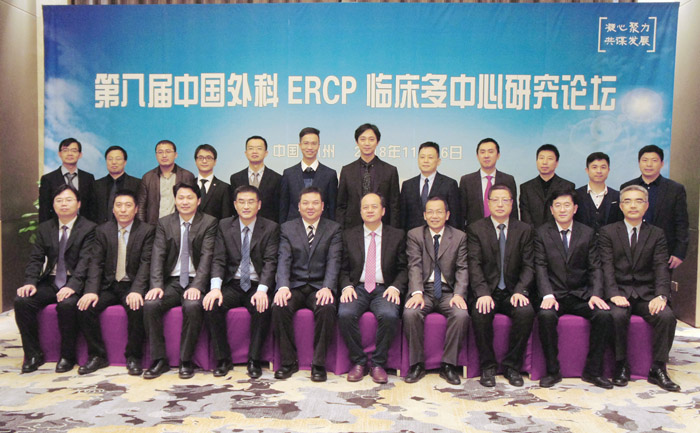Articles of our hospital published online in The Lancet Gastroenterology & Hepatolgy
date:2019/4/17 14:38:58 hot:4088
On April 16th, 2019, The national multi-center team of surgical endoscopy led by Professor Li Xun, the president of the First Hospital of Lanzhou University, has made a breakthrough in a prospective clinical trial of balloon dilatation in ERCP. The relevant article "Optimal dilation time for combined small endoscopic sphincterotomy and balloon dilation for common bile duct stones: a multicenter, single-blinded, randomized controlled tria" has been published online in The Lancet Gastroenterology & Hepatolgy.

Endoscopic sphincterotomy and balloon dilatation(ESBD) is a common procedure for major duodenal papilla during ERCP. It could increase the success rate of stone removal and protect the function of Oddi sphincter to a greatest extent. However, there is no universally acknowledged standard for the optimal balloon dilatation time. This study (ClinicalTrials.gov, ID: NCT02510495) conducted a prospective, multi-central, single-blinded, randomized controlled trial on the optimal balloon dilatation time of ESBD. The 15 institutions involved in the study were well-known ERCP centers in China, including The First Hospital of Lanzhou University, Shandong Provincial Third Hospital, Tianjin Nankai Hospital, Southwest Hospital of Army Medical University, the First Affiliated Hospital of Xi'an Jiaotong University, The Second Affiliated Hospital of Guangzhou Medical University, Second Xiangya Hospital of Central South University, the General Hospital of Ningxia Medical University, General hospital of Taiyuan Iron and Steel Co., Ltd., Xinhua Hospital of Affiliated to Shanghai Jiao Tong University School of Medicine, the First Hospital of Jilin University, The First Affiliated Hospital of Xinjiang Medical University, Union Hospital of Huazhong University of Science and Technology, 2nd Hospital of Hebei Medical University, Shulan (Hangzhou) Hospital and First Affiliated Hospital of Zhejiang University.

In this study, there were 5 groups based on ESBD balloon dilation time : 0 seconds, 30 seconds, 60 seconds, 180 seconds and 300 seconds. A total of 1920 patients with bile duct stones were prospectively enrolled in 15 centers between from 2015 to 2017. The results showed that 30 seconds balloon dilation had not only the same success rate of stone removal, but alsothe lowest incidence of post-ERCP pancreatitis. Small balloon diameter was more likely to increase the incidence of post-ERCP pancreatitis, which provided a crucial evidence for the optimal balloon dilation time of ERCP in patients with choledocholithiasis in China. In addition, the study also defined for the first time the risk factors for post-ERCP pancreatitis in young Chinese women (< 45 years old).

Lancet Gastroenterology & Hepatology is a sub-journal of The Lancet. This article is also the first article published by Chinese mainland scholars as a correspondent author in this journal. This study was discussed and selected by the CHESS Research Group in early stage. It was reported, revised and submitted to Rob Brierley, editor-in-chief of the journal, at the Round Table of Lancet Gastrointestinal Hepatology in December 2018. It then entered the fast-track and was accepted only one month later. The successful publication of this study is not only the result of the joint efforts of 15 surgical ERCP centers in China, but also marks a new step in the clinical research level of general surgery department in the First Hospital of Lanzhou University.
Article link:
Related reading:
The multi-central clinical study of Chinese surgical ERCP was launched by Professor Li Xun, president of the First Hospital of Lanzhou University, in March 2015, and was jointly founded by 15 well-known surgical ERCP centers in China. Up until now, five studies have been initiated and one multi-central clinical study has been completed. This multi-central research platform regularly holds the "Chinese Surgical ERCP Clinical Multi-center Research Forum", aiming at exploring the prominent problems in the development of surgical ERCP in China at this stage, conducting in-depth exploration and research, devoting itself to clinical research, technical training and promotion of surgical ERCP in China, and providing new ideas and new methods for further optimizing the diagnosis and treatment of biliary and pancreatic diseases.
Members of the 15 institutions involved in the study: Professor Li Xun, Professor Zhou Wence, Professor Zhang Kai, Professor Wang Zhenyu, Professor Zhang Leida, Professor Sun Hao, Professor Xue Ping, Professor Liu Wei, Professor Wang Qi, Professor Zhang Jijun, Professor Wang Xuefeng, Professor Wang Meng, Professor Shao Yingmei, Professor Cai Kailin, Professor Hou Senlin, Professor Li Qiyong, Professor Meng Wenbo, Professor Zhang Lei, Professor Zhu Kexiang. At the same time, the study was strongly supported and helped by Professor Joseph W. Leung of the Davis Medical Center of the University of California, Professor Elisabete Weiderpass of the WHO International Agency for Research on Cancer, Professor Ula Nur of the University of Qatar, Professor Kiyohito Tanaka of the Second Red Cross Hospital in Kyoto, Japan, and Professor Azumi Suzuki.
ByYue Ping/Liu Yatao
Edited by International Cooperation and Communication Dept.

